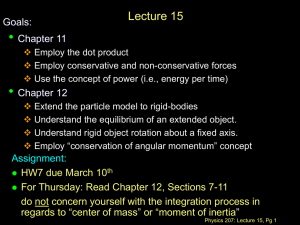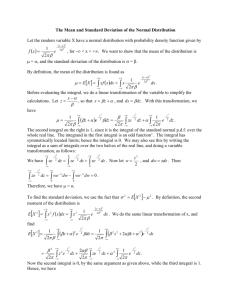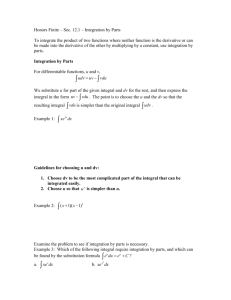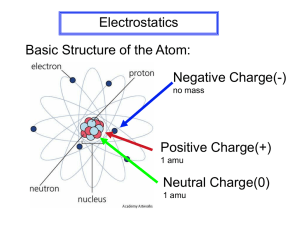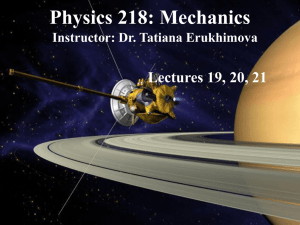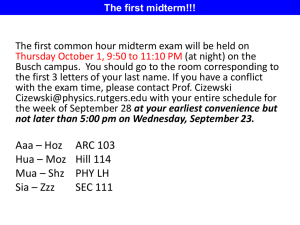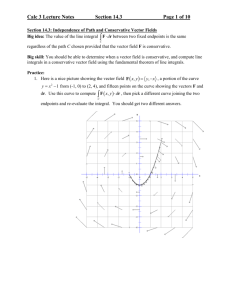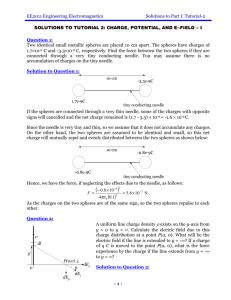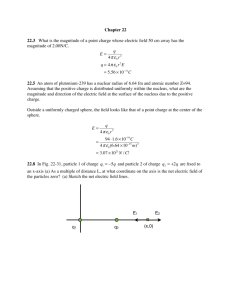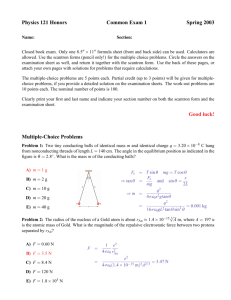PHYS 3343 Lesson 1
advertisement
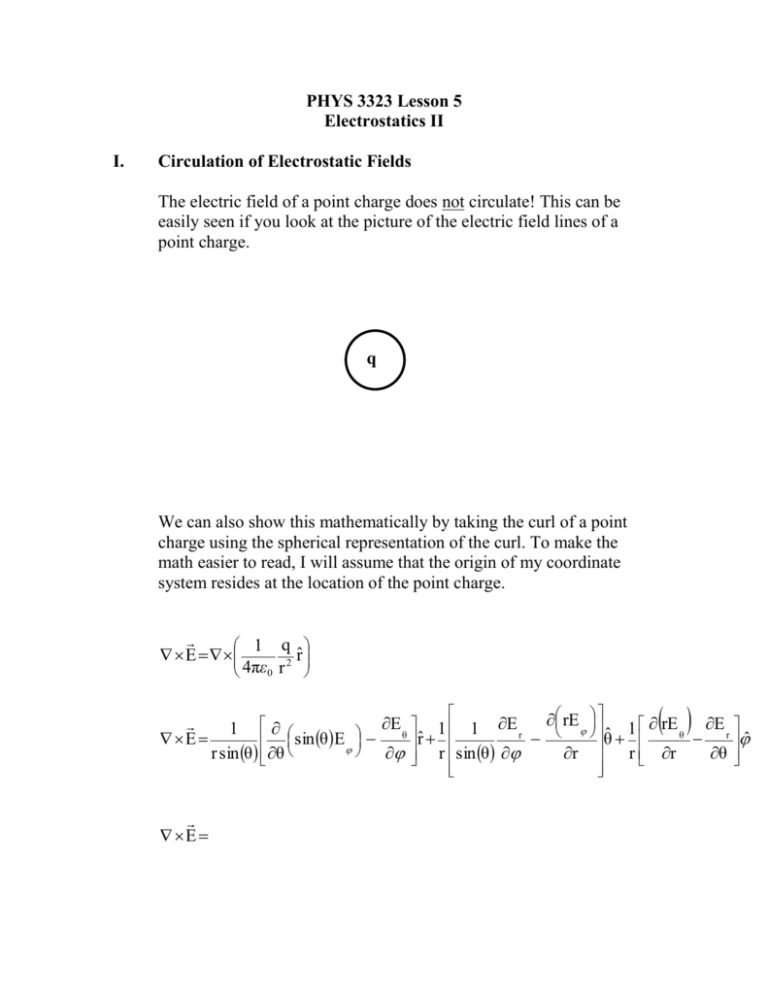
PHYS 3323 Lesson 5 Electrostatics II I. Circulation of Electrostatic Fields The electric field of a point charge does not circulate! This can be easily seen if you look at the picture of the electric field lines of a point charge. q We can also show this mathematically by taking the curl of a point charge using the spherical representation of the curl. To make the math easier to read, I will assume that the origin of my coordinate system resides at the location of the point charge. 1 q E r̂ 2 4πε0 r E rE 1 rE E 1 1 E E 1 θ θ r sin θ E r̂ θ̂ r ˆ r sin θ θ r sin θ r r r θ E Since any electrostatic field is just the sum of the electric fields due to individual point charges, it follows that all electrostatic fields have zero circulation! E 0 This fact has some important consequences which we will now examine. II. PHYS1224 Review A. Definition of Work The work done on an object by a force F as the object is displaced along some path from point A to point B is defined by the equation W F dr B A The work (value of the integral) may or may not depend on the path that the object takes between point A and point B!! If the work done by the force depends only on the initial and final location of the object (i.e. its position) and not the path then the force is said to be conservative. If the work done by the force does depend on the path then the force is said to be non-conservative. You were told in PHYS1224 that a force was conservative if F 0 . You should now realize from chapter 1 that this is a vector property and applies to all vectors and not just forces!! B. Work-Energy Theorem The work energy theorem is the central connection between our energy concepts and Newton’s second law. It says that the work done by the net external force (vector sum of all the external forces) acting upon a body is equal to the change in the kinetic energy of the body. WNet F d r ΔK i B N A i C. Potential Energy We can now split our work terms into two sums depending upon whether the forces are conservative or non-conservative. B WNet Fconservative d r Fnon-conservative d r ΔK B A A The first term is the net work by conservative forces while the second term is the net work by non-conservative forces. Rearranging our equation, we have B F d r ΔK F d r non conservati ve conservati ve B A A The integral on the left hand side of the equation which is the work by non-conservative forces can not be solved without specifying the unique path traveled by the object. The integral on the right hand of the equation depends only upon the endpoints (the initial and final position of the object) and not upon the path. Thus, someone else can choose a path and perform the integral for you! Furthermore, we see by dimensional analysis that this integral must be a change in energy. This leads us to define a new type of energy – POTENTIAL ENERGY. The negative of the work done by a conservative force is equal to the negative of the change in the potential energy of a body due to that force. B ΔU Wconservative Fconservative d r A IMPORTANT POINTS 1. Only changes in potential energy are defined. It makes no sense to talk about potential energy at a point!! We always mean the potential energy with respect to some arbitrary zero potential energy reference point. 2. III. Potential energy functions can only be defined for conservative forces! Electrical Potential Energy and Electric Potential We can now find the work done by an electric force on a test charge as the test charge moves from point A to point B. B Q A B W F d r Q E d r B A A We see that the work depends on the charge of our test object in the same way that the electric force depends on its charge and the work done on a test object by gravity depends on the test object’s mass. We can remove this dependence using the same trick that we used to obtain the electric field. In this case, we are finding a work per charge. W E dr Q A B We can see that the work per charge done on our test charge for a closed path is the circulation of the electric field!! Wclosed path Q E dr EMF Historically, this quantity is called the electromotive force (EMF) which is a very unfortunate name since it is not a force or even a vector!! For electrostatic fields, the electric force is conservative (i.e. electric fields do not circulate). In this case, it is meaningful to talk about the change in the electrical potential energy of our test charge. From our work above, we see the change in the electrical potential energy per charge of the test charge as it moves from point A to point B is given by B ΔU - W E dr Q Q A This ratio of the change in the electric potential energy divided by the test charge is called the change in the electric potential or voltage! ΔV ΔU Q You should note that all of the properties mentioned previously about potential energy functions effect electrical potential functions since electric potential is defined in terms of electrical potential energy! We also decided to name a new unit. The units of electrical potential by dimensional analysis are Joules/Coulombs. A Joule/Coulomb is called a volt after Alexandra Volta who developed the battery. IV. Connection Between Electrical Potential and Electric Fields From our work in the previous section, we see that one can obtain the electrical potential difference between two points in space if you know the electric field using the formula ΔV E d r B A This formula is useful for developing relationships for the electrical potential of simple devices where the electric field can be calculated by Gauss’ law. However, the formula is not used when making real world calculations! This is because the reason for using electric potential is to avoid the mathematical difficulty in solving the vector integral required to find the electric field! Electrical potential is a scalar and so the math including integration is often simpler. If we know or can calculate the change in electrical potential, how do we find the electric field? The answer is provided in chapter 1. The change in a function between two points is equal to the integral of the gradient of that function along any path between the two points! ΔV V d r B A By comparison with our previous formula, we then have the following relationship between the electric potential and an electrostatic field E V It is important to note that this formula is only true for a conservative electric field (i.e. electrostatics!). It is probably a good time to reread both your PHYS2424 textbook’s chapter on electric potential and chapter of your E&M text so that you see all the connections from different perspectives. V. Electric Potential of a Test Charge You should memorize the formula for the electric potential due to a single point charge. This is because more complicated systems can be considered to be the sum of the contributions due to a collection of point charges. Vr 1 q 4πε0 r Proof: Consider a point charge q located at the origin and assume that our zero electrical potential reference point is at r = . r= r q VI. Electrical Potential for a Collection of Point Charges A. Discrete Point Charges The total electric potential due to a collection of point charges is given by Vr 1 4πε 0 N qi i 1 i r This is a scalar equation and easier to calculate than for electric fields. B. Continuous Charge Distribution The total electric potential for a continuous charge distribution is given by Vr 1 4πε 0 dq r all charges If the charge is spread throughout a volume, we would write the infinitesimal differential charge dq in terms of the charge density and our formula becomes Vr 1 4πε 0 ρr'dv' r all space We can integrate over all space and not just the charge volume since the additional volumes where the charge density is zero don’t add to the integral. VII. Poisson’s Equation and Laplace’s Equation We will run into many problems in which we will not know charge density or where we will want to avoid solving integrals. For instance, if a charge is near a conductor it will induce the charges on the conductor to redistribute in a way that we don’t know a priori. Thus, it would be useful to find a differential equation for the electric potential that we could solve instead of an integral equation. We start by considering the divergence of the electric field (Gauss’ law) ρ E ε0 For electrostatic fields, we can insert our relationship between the electric field and the electric potential V ρ ε0 Thus, we have Poisson’s equation. 2V ρ ε0 If there is no charge density in the region where you are solving for the electric potential, Poisson’s equation reduces to the simple Laplace’s equation. 2V 0 We will study some special techniques for solving these equations in chapter 3.
